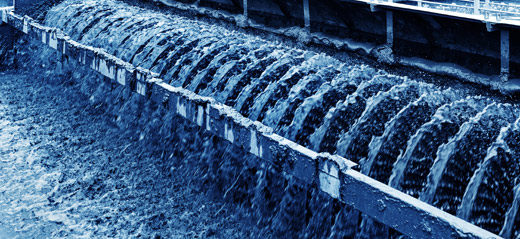Conservation and Reuse of Reclaimed Wastewater: A Marriage of Necessity

As the population of Texas increases and requires a more abundant water supply, big decisions loom regarding new water sources, growing volumes of wastewater effluent, and the impacts on our land, environment, and other species in which we coexist.
A new way of thinking is taking root since traditional approaches to water management are generally viewed as deficient in the face of current water-related challenges. It promises a more viable, alternative approach. One Water is not an entirely new concept, but it offers an instructive framework, nonetheless, for reimagining our relationship with water.
In this post, I’ll share the results of a project completed with my graduate student, Ty Stonecipher, and funding support from the Cynthia and George Mitchell Foundation.
We set out to consider the potential for land application of treated wastewater effluent from fast-growing cities in the Texas Hill Country that have either recently expanded their wastewater treatment capacity or will soon need to. One potential benefit from this strategy is to keep nutrient-rich effluent from being discharged to Hill Country streams that are historically clear running and in intimate contact with the groundwater below.

Of course, the land application of treated wastewater on karst topography has its challenges. The promise behind this exploration is to achieve multiple benefits—a vital characteristic of the One Water approach. Such benefits might include, for example, a new source of water for new or enhanced agricultural production (e.g., hay), an alternative source of water to the pumping of groundwater, and a potential incremental source of revenue for the local water service provider.
Employing a geographic information system, publicly available data, and weighted-selection criteria, we narrowed the list of candidate cities from 27 to nine. Another round of analysis ensued based on criteria including the location of a city’s wastewater treatment plant (WWTP) relative to the contributing and recharge zones of the Edwards Aquifer regulatory boundary, level of effluent production relative to the maximum permitted daily discharge, and land-use characteristics deemed suitable for land application within a 3-mile radius of the WWTP.
From these criteria, we chose the cities of Blanco, Boerne, and Leander as our study sites.
Current and future effluent volumes determined acreage for land application. We based the application rate on one of the more conservative permitted rates found nearby; and applied another round of weighted-selection criteria to determine the acreage and location of ideal sites for land application.
Here’s what we discovered:
Blanco can meet 100 percent of its current and future needs for land application within a one-mile radius using only sites deemed to be the most desirable (i.e., highest scoring) for this purpose. moreover, 100 percent of the highest-scoring sites identified for Blanco are outside of the regulatory boundary of the Edwards Aquifer. Thus, Blanco appears to be an ideal candidate for reuse of treated wastewater. Seizing the opportunity could provide more evidence that all water has value, a characteristic of the One Water approach.
The City of Boerne can meet current needs with high-scoring sites identified within a one-mile radius of the WWTP. Meeting Boerne’s future needs within one mile will require that some of the future effluents be applied to a more diverse suite of sites in terms of the site scores developed. The city needs to move fast, however, as development pressures will foreclose the use of some of the ideal sites before too long.
The City of Leander can meet current needs within one mile of the WWTP studied using highly suitable sites. Given Leander’s population projections and the volume of effluent that is expected, it appears infeasible for the city to rely on land application despite extending the radius of inquiry out to three miles. Leander may be best served by other reuse options: direct-potable reuse, dual plumbing in new developments, and industrial reuse not considered in our study. This potential suite of options, along with other strategies, including demand management, would be indicative of the “systems mindset” necessary to capture another characteristic of the One Water approach.

Whether it’s with land application of reclaimed wastewater or some other holistic way of managing water, the limiting factor isn’t technical or physical know-how. In laying out the unifying characteristics of a One Water approach, some of which have been mentioned, the US Water Alliance suggests that we deploy watershed-scale thinking and action.
John Wesley Powell argued for something similar in 1890. Then as now, this thinking is challenged by the way we’ve organized our political jurisdictions. But we all live in a watershed nonetheless, either upstream from someone who will be impacted by our water-use decisions or downstream of someone who is affecting our water quality and availability. I sense that the most limiting factor to operationalizing One Water is more broadly related to another characteristic of the One Water approach: partnerships and inclusion.
As Brian Richter describes in Chasing Water, we need more enduring and inclusive community-based collaboratives where leaders and others come together to create a vision for a shared water future. This will help ensure that there are partnerships, alliances, and promising examples to build upon, thus fulfilling the promise of One Water.
This will require a commitment to an ongoing and long-term community conversation.
Of the competing interests, short-term objectives, and shorter attention spans that collectively must be reconciled, I’m inspired by Freeman House. House writes in Totem Salmon: Life Lessons from Another Species: “Consensus needs to be understood as the practice of community-building in the context of living places. Its appropriate analog is not politics but the process of natural succession. It is an ongoing collective meditation that allows for conflicting ideologies to gradually be dissolved by a growing sense of mutuality.”
I write as the novel coronavirus reminds us of how interconnected we are. Water connects us too. Let’s foster the practice of watershed-based, community building that will leave the Texas Hill Country and other cherished landscapes rich in life, with clean and abundant water for generations to come.
Tim Loftus is professor of practice in geography and Meadows endowed chair in water conservation at Texas State University in San Marcos. A water resource planner, he recently spent ten years with the Chicago Metropolitan Agency for Planning where he managed Clean Water Act related efforts and led development of and implementation support for Water 2050: Northeastern Illinois Regional Water Supply/Demand Plan. Tim earned his master’s degree in forestry and doctorate in geography from Southern Illinois University Carbondale. He also served as a faculty member at Eastern Kentucky University and director of the water quality laboratory at Heidelberg College in Tiffin, Ohio.
Editor's note: The views expressed by contributors to the Cynthia and George Mitchell Foundation's blogging initiative are those of the author and do not necessarily represent the views of the foundation. The foundation works as an engine of change in both policy and practice, supporting high-impact projects at the nexus of environmental protection, social equity, and economic vibrancy. Follow the foundation on Facebook and Twitter, and sign up for regular updates from the foundation.

Hide Full Index
Show Full Index
View All Blog Posts